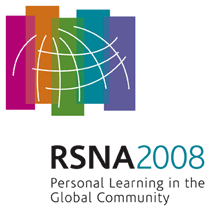
Abstract Archives of the RSNA, 2008
LL-IN2089-R01
Impact of Voice Recognition (VR) System on Radiology Report Turnaround Time (RTT)
Scientific Posters
Presented on December 4, 2008
Presented as part of LL-IN-R: Informatics
Arun Krishnaraj MD, Presenter: Nothing to Disclose
Joseph K.T. Lee MD, Abstract Co-Author: Nothing to Disclose
Sandra A. Laws, Abstract Co-Author: Nothing to Disclose
Computerized voice recognition (VR) has existed for over 30 years but has only recently been more widely adopted in radiology departments. Several recent articles have documented improvement in RTT. However, none have examined the effect of individual work habits on RTT improvement related to VR. The purpose of this study is to assess the impact of individual work habits by comparing RTT before and after VR for a department, for each individual faculty, and for each of 8 subspecialty sections.
Data from our 700-bed academic hospital radiology department was collected 9 months before (Jan-Sept 2006) and 9 months after (Apr-Dec 2007) the implementation of a VR system after a 6 month “wash in” period (Oct 2006-Mar 2007). RTT (defined as the interval between the time when a case was available for interpretation on the PACS to the time when the case was verified by an attending physician) was calculated before and after VR for the department, each faculty, and each subspecialty section.
The average RTT for the department was 28 hours (range 4.6-65.9) before VR and 12.7 hours (range 1.2-47.3) after VR. The average RTT for the 8 sections ranged from 13.3 hours (range 6.7-30.1) to 50 hours (range 37.7 –59.7) before VR and from 1.8 hours (range 1.2-2.5) to 23.2 hours (range 15.1-33.3) after VR. The average RTT time for 30 faculty ranged from 4.6 hours to 65.9 hours before VR and from 1.2 hours to 47.3 hours after VR. VR has resulted in a decrease in RTT for the entire department and each of the 8 sections. The RTT also decreased for each individual faculty except two who had an increase of 4 and 8 hours respectively. Six of 9 faculty who had the shortest RTT (average 11 hours, range 4.6-19.1) before VR continued to have the shortest RTT (average 3.5 hours, range 1.2-5.5) after VR. Conversely, 3 of 6 faculty who had the longest RTT (average 50 hours, range 40-65.9) before VR continued to lag behind after VR (average 31.2 hours, range 18.5-47.3).
The implementation of a VR system resulted in decreased RTT. However, the rank order of individual faculty did not change significantly suggesting that individual work habits may affect the effectiveness of a new technology.
Recognition of the impact of individual work habits on the effect of productivity-enhancing technology may facilitate the design and implementation of similar technologies in the future.
Krishnaraj, A,
Lee, J,
Laws, S,
Impact of Voice Recognition (VR) System on Radiology Report Turnaround Time (RTT). Radiological Society of North America 2008 Scientific Assembly and Annual Meeting, February 18 - February 20, 2008 ,Chicago IL.
http://archive.rsna.org/2008/6012083.html

